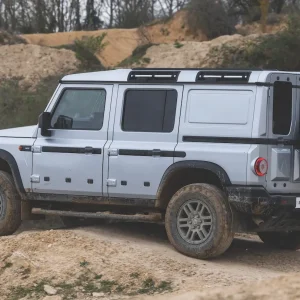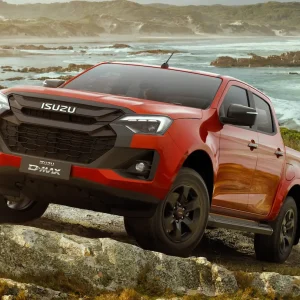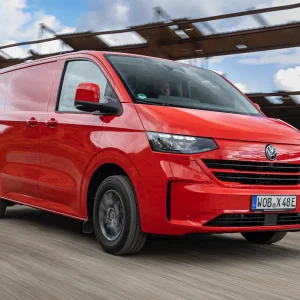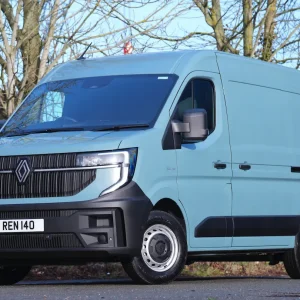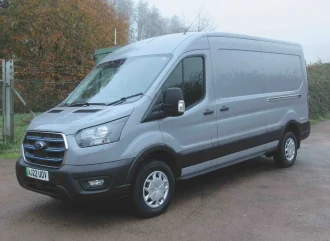
Ford is going electric and is doing so with its usual two-fisted marketing vigour. It argues that E-Transit – the What Van? Van of the Year for 2023 – comes at a sensible price, offers a more-than-respectable range, and can deliver plenty of power if that is what is required.
That power comes courtesy of an electric motor pumping out either 135kW/184hp or a heart-stopping 198kW/270hp. Top torque is 430Nm in both cases.
Also in E-Transit’s favour is the breadth of the range, which encompasses 25 variants of van, double-cab-in-van and chassis cab. Gross payload goes up to well over 1.7 tonnes on the van model, while gross weights run from 3.5 to 4.25 tonnes.
Two specification levels are up for grabs – Leader and the more-upmarket Trend. Both offer more kit than the equivalent diesel model says Ford.
Of considerable potential value to trades people who make use of power tools is the availability of ProPower Onboard. It delivers up to 2.3Kw and can also be used to drive ancillary equipment.
We got to grips with a 350 L3 H2 van in Trend trim fitted with the least-powerful of the two motors. Here’s how we got on.
Load bay
Entrance to the 11.0m3 cargo area is by means of a sliding nearside door and through twin back doors which can be swung through 90°. Release the stays – an easy task – and they can be pushed through 180°.
A step aids entry through the rear aperture; just as well given that the load floor sits a little high thanks to rear-wheel-drive.
With ten tie-down points, there is no excuse for failing to strap down cargo. If you forget, then the full-height bulkhead should prevent items from ending up in the cab.
Good to see four interior lights – handy if you happen to be loading and unloading at night. Payload capacity is under a tonne however, which is somewhat disappointing.
Ford’s published specification sheets give no indication as to whether E-Transit is allowed to tow a trailer or not. So we’ll assume it isn’t.
Interior and equipment
The big blue oval has developed a wide-ranging package of support services for its light commercials under the Ford Pro banner, and all E-Transits feature a FordPass Connect modem enabling always-on connectivity. Ford Power-Up enables over-the-air updates while a FordPass Pro app allows small fleets to manage charging schedules remotely; set a van cab’s temperature to a comfortable level prior to departure; and fires off an alert if an alarm has been triggered.
E-Transit comes with Ford’s SYNC-4 communications and information package controlled by a 12in touchscreen which dominates the centre of the three-seater cab’s dashboard. While Ford describes its operation as intuitive, make sure you understand what it does and how it does it before you drive anywhere.
The last thing you want is to be frantically pressing it to no avail when you are heading down a busy street because you need to operate something which in the past would have been controlled by a simple dashboard switch. The screen is in fact complemented by a row of conventional buttons which among other things turn the radio on and off, alter the volume, and demist the windscreen.
Trend trim includes a connected satellite navigation package that can, for example, update drivers on the availability of charging points. Such updates are covered by a complimentary one-year subscription, with payment required thereafter.
The same approach also embraces free-of-charge access to the BlueOval Charge Network of over 300,000 charging points across Europe for a year.
Our E-Transit boasted air-conditioning, heated front seats, cruise control with an adjustable speed limiter, front and rear parking sensors, a DAB radio, Android Auto, Apple CarPlay, front fog lights and a driver’s airbag.
Electric windows were fitted along with large, electrically-adjustable and heated, exterior mirrors with a separate wide-angle lower section.
Instrument panel dials tell you how much range you have got left, how much charge remains in the battery, and how much power you are using. Stay in the green section if you can, to minimise consumption, and in this context it is worth remembering that E-Transit’s onboard computer features an Eco coach to help you drive more frugally.
With big bins in each of the doors – the one on the driver’s side features a moulding to accommodate a large bottle of water – there is no lack of in-cab storage space.
The roomy glovebox is lockable, and three shelves and a trinket tray sit on top of the dashboard. More shelves are positioned above the windscreen while yet another shelf just above the instrument display plays host to a 12v socket and a USB port.
You will find a cup-holder plus a bottle holder at each extremity of the fascia.
The driver’s seat and the steering column are both height-adjustable, and the latter boasts remote controls for the radio. The seat offers lumbar adjustment.
Space beneath the seats provides you with somewhere to stow the 8m Mode 3 32amp charging cable, which comes as standard. Fold down the centre section of the middle seat’s back and you’ve got yourself a desk with a couple of cup-holders.
The rotary switch that controls the single-speed transmission sits on a moulding which projects from the centre of the dashboard. Both the moulding, which features yet another cup-holder, and the bin close to it steal legroom from the middle passenger.
Starting is keyless and the parking brake is electronic. You engage and release it using a button on the dashboard.
Aside from the usual devices such as Electronic Stability Control, safety systems include Lane Keeping Assist. Also installed is Pre-Collision Assist with Intelligent Emergency Brake Assist to help prevent you from mowing down pedestrians, or colliding with the vehicle in front.
The positioning and heft of the electric motor, which is located within the back axle, has prompted Ford to redesign the rear suspension, which is now independent with coil rather than leaf springs. Our demonstrator sat on 16in steel wheels graced by plastic trims and shod with Michelin Agilis 235/65 R16C tyres.
Powertrain
E-Transit’s electric motor is fed by a lithium-ion battery pack. Ford says it delivers 68kWh of usable capacity as standard and a range of up to 197 miles between recharges according to WLTP (Worldwide Harmonised Light Vehicle Test Procedure) figures.
The charging point is at the front of the van, beneath the Ford logo.
Plug into a 7.4kW wall box and it will take 11.5 hours to recharge your van from scratch says the manufacturer. That shrinks to just over eight hours if your have access to an 11kW three-phase socket, it adds.
If you’re in a hurry however then it takes 34 minutes to charge the battery from 15% to 80% of its capacity using a 115kW DC fast-charger, says Ford.
The rotary transmission switch referred to earlier offers you the choice of Park, Reverse, Neutral and Drive. Pressing the L button in the middle of the switch gives you braking regeneration, which pumps energy which would otherwise be wasted into the battery.
Driving
E-Transit displays sure-footed handling and delivers strong acceleration all the way up to the maximum legal motorway speed, if you don’t mind depleting the battery charge. The 135kW/184hp motor packs more than sufficient punch for most applications, even if you are in the habit of running at maximum gross weight, and disgorges its power smoothly.
It does so quietly too, although this means that all the other sources of noise (tyres, suspension and so on) become a lot more obvious than they would if you were driving a diesel.
As with so many vans of its size, the ride is on the choppy side when unladen, but gets calmer and calmer the more weight you load onboard.
During our time with E-Transit we took it on a short trip in icy winter weather complete with freezing fog. Not surprisingly we had the heater turned up full blast, the heated seats on and the exterior lights blazing away.
Result?
We started our journey with a projected range of 132 miles and travelled on a round trip of just 11 miles, driving slowly and carefully because of the awful conditions. Once we got back to base, we saw that the projected range had tumbled to 107 miles rather than the 121 miles we would have expected.
The noticeable drop in the projected distance we could expect to travel between recharges might have reflected the presence of Intelligent Range on Trend models; a system which Ford says gives a highly-accurate prediction of how soon the battery will be completely depleted. It also serves to underline the inescapable fact that no matter what make and model of electric van you opt for, low temperatures will curtail your travelling distance; something to bear in mind when you are making your selection.
We were driving in Normal mode. We feared that Eco might be a no-no because of the impact it was said to have on the heater, and we had no need to select Slippery – the third choice – because there was no ice or snow on the highway.
We subsequently discovered that Eco’s effect on the heating is not as dramatic as we expected. Nor does it throttle the van’s on-highway performance unduly if you are lightly-laden, although Normal makes better sense if you’ve got a bit of weight onboard.
Regenerative braking helps preserve the range, but the system Ford has opted for is a little odd.
Using the L button referred to earlier is straightforward enough, but what you can do instead is tap the brake pedal once to get a lesser degree of regeneration. Tap it twice and you are up to L level (which isn’t especially impressive if we’re honest about it) which then turns itself off the minute you accelerate.
Operating
Ford estimates that E-Transit will cost 40% less to service, maintain and repair than equivalent diesel models.
Service intervals are set at 12 months with no mileage limit and a 12-month roadside assistance package is provided which includes rescue charging.
The basic warranty is three years/100,000 miles but the battery and high-voltage electrical components are protected by an eight-year/100,000-mile warranty. It can be triggered if a van’s battery declines to 70% of what its capacity was when new.
A 12-year anti-perforation corrosion warranty is present as well.
While we appreciate the need to keep E-Transit’s unladen weight down in order to maximise its range, we were disappointed to see that a full-size spare wheel had been sacrificed in favour of an inflator/sealer which lurked under the driver’s seat. On a more positive note, deep side rubbing strips help protect the body from minor damage.
Ford E-Transit Trend 350 L3 H2 135kW/184hp van
Price (ex VAT) £52,035**
Price range (ex VAT) £48,045 – £57,235 **
Gross payload 951kg
Load length 3533mm
Load width (min/max) 1392mm/1784mm
Load bay height 1786mm
Load volume 11m3
Loading height 695mm
Rear door aperture 1565mm x 1648mm
Side door aperture 1300mm x 1600mm
Gross vehicle weight 3500kg
Braked trailer towing weight N/A
Residual value 33.7%*
Cost per mile 73.8p
Engine size/power 135kW(184hp) electric motor
Torque 430Nm
Gearbox 1sp
Range 197 miles (WLTP)
Battery 68kWh
Warranty 3yrs/100,000mls (battery 8yrs/100,000mls)
Service intervals 1yr/unltd miles
Insurance group 44A
Price as tested £52,035
* After 48 months/20,000 miles p.a – source – KWIKcarcost
** Basic price before government
Plug-in Van Grant
Rivals
Fiat Professional E-Ducato
Price (ex VAT) £56,625–£76,520 **
Load volume 10–17m3
Gross payload 690–1885kg
Electric motor 90kW
Verdict: Offering a choice of battery packs (47kWh or 79kWh) and WLTP ranges – 230 miles is the maximum that is cited – makes sound sense and could be what many operators are looking for. Many businesses that find they rarely venture beyond their home turf may favour a smaller battery with a shorter range that is comparatively quick to charge while also letting them carry more weight.
Mercedes-Benz eSprinter
Price (ex VAT) £57,870 **
Load volume 11m3
Gross payload 731kg
Electric motor 85kW electric
Verdict: If you are contemplating acquiring an eSprinter then the best advice we can give you is to wait. A new version has been unveiled with a choice of battery sizes and a claimed WLTP range of up to 310 miles. That must be counted as an improvement on the modest 96 miles offered by the current model. The newcomer will not be available
in the UK until the back end of this year/early 2024 however and prices have yet to
be released.
Renault Master E-Tech
Price (ex VAT) £48,400–£49,200 **
Load volume 10.8–13m3
Gross payload 1308–1420kg
Electric motor 57kW
Verdict: Last year saw Renault roll out an upgraded version of Master E-Tech with a bigger 52kWh battery said to be good for a 126-mile range under WLTP testing; better than the meagre 75 miles offered previously. Pricing is competitive and payload capacity is considerably better than what is on offer from rival products. Remember that Master E-Tech is marketed by Renault Trucks as well as through Renault car and van dealerships.
The Final Verdict
Design 8/10 – A cleverly-thought-out package that propels electric vans into the mainstream
Cabin 8/10 – A comfortable working environment with plenty of storage space
Ride 7/10 – Choppy when the van is lightly-laden, but firms up with weight aboard
Refinement 8/10 – Well-built with zero squeaks and creaks
Load area 6/10 – Plenty of tie-down points, but payload capacity is poor
Handling/performance 8/10 – Both are to a high standard, but Ford’s regeneration system needs a rethink
Engine/transmission 9/10 – 135kW is ample for most requirements and motor and transmission combine well
Standard equipment 8/10 – Can’t help but love the SYNC 4 comms and info system
Operating costs 9/10 – Servicing costs look low and warranty package looks generous
What Van? subjective rating 8/10 – Has its drawbacks, but on balance it must be viewed as a winner
Overall Rating = 79/100

